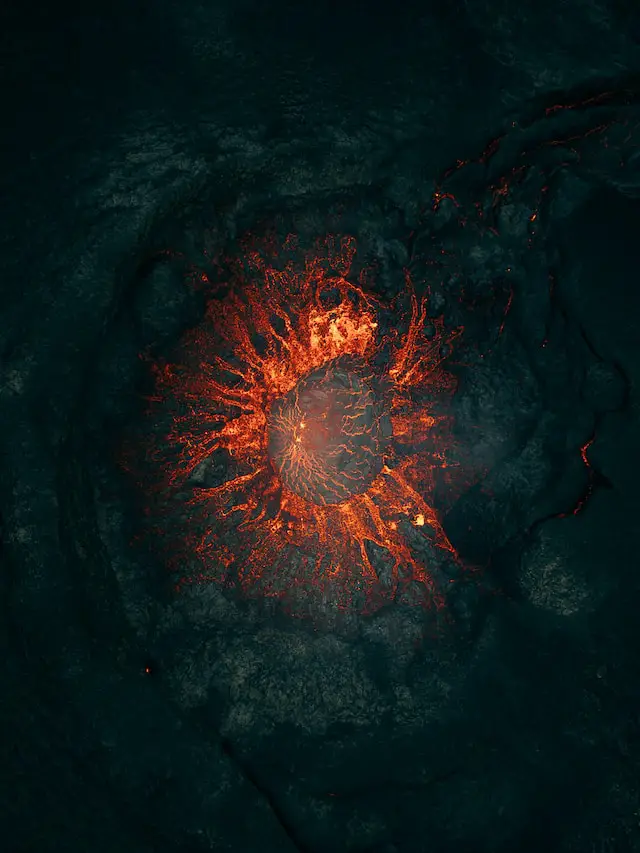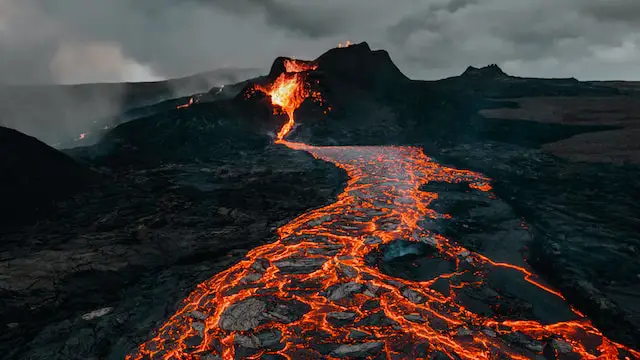Magma and lava are two different terms that describe the same substance in different states. Magma is molten rock beneath the Earth’s surface, while lava is magma that has erupted onto the Earth’s surface. The key differences between them include their location, temperature, viscosity, and composition.
What is magma?
(Photo by Martin Sanchez on Unsplash )

Magma is a molten rock substance that is found beneath the surface of the Earth. It is created by heat and pressure, which causes solid rocks to melt and become liquid. This process can occur in various parts of the Earth’s mantle, such as subduction zones or hotspots.
Once magma has formed, it begins to rise towards the surface due to its lower density compared to surrounding rocks. As it rises, it may encounter different types of rock formations and interact with them in various ways, leading to changes in composition or temperature.
The physical properties of magma depend on several factors, including its chemical composition, temperature and pressure conditions. Some magmas are more viscous than others due to their higher silica content or other minerals present within them.
Volcanic eruptions happen when magma reaches the Earth’s surface through fissures or vents. Depending on its viscosity and gas content, lava flows can vary greatly in their behavior – from slow-moving domes to explosive pyroclastic flows that shoot high into the air.
Understanding what magma is helps us make predictions about volcanic activity and better prepare for potential hazards associated with it.
What is lava?
(Photo by Tetiana Grypachevska on Unsplash )

Lava is molten rock that has been expelled from a volcanic vent or fissure onto the Earth’s surface. It can range in temperature from 700 to 1,200 degrees Celsius and can have varying levels of fluidity depending on its composition.
Once lava reaches the Earth’s surface it cools and solidifies into volcanic rock. The type of rock formed depends on the chemical composition of the lava and how quickly it cooled.
The texture of lava can also vary widely depending on factors such as gas content, viscosity, and cooling rate. Some types of lava are smooth and glassy while others are rough and jagged.
Lava flows slowly down slopes due to its high viscosity, which means that it has a resistance to flow. However, if there is enough pressure behind it or if the slope is steep enough then lava flows much faster.
In addition to being incredibly destructive when it comes into contact with human settlements or infrastructure, Lava also plays an important role in shaping landscapes over time through volcanic eruptions that create new landforms such as islands or mountains.
Magma Vs. Lava – Key differences
Magma and lava are often used interchangeably, but they actually have some key differences. Magma is molten rock that is found beneath the Earth’s surface. It can be found in magma chambers or pockets within the crust.
Lava, on the other hand, is molten rock that has erupted from a volcano or fissure and flows along the surface of the Earth. The main difference between magma and lava is their location – magma stays underground while lava reaches the Earth’s surface.
Another important difference between magma and lava is their chemical composition. Magma tends to have more dissolved gases than lava because it hasn’t been exposed to atmospheric pressure yet. Lava also tends to have a different texture because it cools quickly when exposed to air.
The temperature of both substances can vary depending on where they’re located – in general, magma temperatures range between 700°C-1300°C (1292°F-2372°F), whereas lava temperatures range from around 700°C–1200°C (1292°F-2192°F).
Understanding these differences between magma and lava helps us better understand how volcanoes work and how we can predict eruptions. By studying the chemical composition of these substances, scientists can gain insight into what types of volcanic hazards may occur during an eruption.
The benefits of magma
Magma is a molten rock substance that exists beneath the Earth’s surface. While it may seem like magma has no benefits, it actually plays an important role in our planet’s geological and biological processes.
One of the main benefits of magma is its ability to create new landmasses through volcanic eruptions. When magma rises to the surface and erupts, it can form mountains, islands, and other geological formations over time. These new landmasses provide habitats for various species of plants and animals.
Additionally, magma contains minerals such as iron, copper, gold, silver and many others that are used in modern society for industrial purposes. The mining industry heavily relies on these minerals found in hotspots where there was once volcanic activity.
Furthermore, geothermal energy is another benefit derived from magma with power stations built near areas with active volcanoes tapping into this renewable source to generate electricity sustainably.
While we mainly focus on lava when we think about volcanoes; however without Magma forming underneath lava wouldn’t even exist making Magma extremely important!
The benefits of lava
Lava is undoubtedly one of the most fascinating and intriguing substances on Earth. It may look like a destructive force, but it has several benefits too.
One of the most significant advantages of lava is its ability to create new landforms. When lava flows from a volcano and cools down, it solidifies into various shapes and structures that can become new landscapes or even islands.
Another benefit of lava is its nutrient-rich properties that enhance soil fertility. Lava deposits contain minerals such as potassium, phosphorus, calcium, iron, and magnesium which are beneficial for plants’ growth.
In addition to soil enrichment, heated water from volcanic areas can be used for geothermal energy production. This renewable source provides heat for homes and electricity generation without releasing greenhouse gases in our environment.
Moreover, thanks to its porous nature, lava rock makes an excellent filtration media for aquariums and water treatment systems. Its unique structure allows water to pass through easily while trapping impurities like debris or sediments.
Many people use crushed lava rock as mulch in their gardens because it helps retain moisture better than other types of rocks while also improving drainage.
There are numerous benefits linked with this molten substance we call Lava!
What is the difference between lava and volcanic rock?
Lava and volcanic rock are closely related but distinctly different. Lava is the molten rock that flows out of a volcano during an eruption, while volcanic rock refers to any type of rock formed from magma or lava.
One significant difference between them lies in their composition. Lava is usually composed of silicate minerals like basalt, andesite, or rhyolite. These minerals form when magma cools and solidifies on the Earth’s surface. Volcanic rocks, on the other hand, can be made up of various materials such as ash, pumice or even obsidian.
Another difference between these two types of substances is their texture. Lavas are typically smooth due to rapid cooling at the Earth’s surface which prevents crystals from forming within it. On the other hand, volcanic rocks often have a grainy appearance due to slow cooling inside pockets beneath the Earth’s surface where they were formed.
Moreover, lava tends to be dark in color since its mineral content has not had time to fully crystallize before being exposed to air while volcanic rocks can come in all colors depending on their specific chemical composition.
While both lava and volcanic rocks may look similar at first glance – especially if you’re not a geologist — understanding what sets them apart can offer valuable insights into how our planet works!
What are the 4 types of lava?
There are four main types of lava, and each one has its unique characteristics. The first type is called Aa or blocky lava, which is extremely rough and jagged with sharp edges. This type of lava forms when the surface cools quickly, while molten rock continues to flow underneath.
The second type is Pahoehoe (pronounced “pa-hoy-hoy”) lava that appears smooth and ropey in texture due to its low viscosity. It forms when hot magma flows slowly over a long distance without significant cooling.
The third kind of lava is Pillow Lava, which gets its name from the fact that it looks like stacks of pillows piled up on top of one another. This type usually occurs underwater or near bodies of water where the rapid cooling causes it to form rounded shapes.
There’s Vesicular Lava that contains numerous small holes known as vesicles formed by trapped gases during solidification. The gas bubbles give this type an unusual spongy appearance.
Understanding these different types can be helpful for scientists studying volcanic activity and predicting eruptions accurately.
Can lava dissolve bones?
One of the most commonly asked questions about lava is whether it can dissolve bones. The short answer is no, lava cannot dissolve bones.
Lava is made up of molten rock that has been heated to incredibly high temperatures, often exceeding 1,000 degrees Celsius. This extreme heat means that anything in the path of a lava flow will be destroyed or incinerated almost instantly.
However, bones are comprised mostly of calcium phosphate and other minerals which have a very high melting point – much higher than the temperature at which lava flows. This means that when exposed to direct contact with molten rock, they will not dissolve but rather become charred and broken apart by the intense heat.
It’s worth noting though that while bones themselves won’t necessarily melt in contact with lava, any organic matter surrounding them such as flesh or muscle would likely burn away quickly leaving only bone fragments behind.
While it’s true that exposure to volcanic activity can result in devastating consequences including injury and death for humans and animals alike; there’s no need to fear your body disappearing into thin air upon encountering hot magma!
Featured Image By – Toby Elliott on Unsplash








